How To Care For Your Strelitzia Nicolai (BIRD OF PARADISE)
Strelitzia Nicolai, also known as the White Bird of Paradise or Wild Banana, is one of the easiest large indoor...
We buy so you won’t have to! We earn commissions from recommended products, which fund testing new items by our team of experts. Thank you for your support!
Marble Queen Pothos (Epipremnum aureum, ‘Marble Queen’) is an easy-to-take-care-of indoor plant with a white and cream variegation. The ability to adapt to low light, such as dark rooms and offices, makes it the perfect houseplant. It has tropical vines that look similar to Philodendron and comes in a wide range of leaf colors and patterns.
Marble Queen Pothos is known for improving the air quality in the house, but be careful around pets because it can be toxic to them.
Continue reading to learn everything I know and what you should know too, so you can keep this amazing plant healthy and growing.
If you’re in a rush, here are the main things you should know to care for Queen Pothos:

Like most pothos plants, marble queen pothos loves indirect sunshine. While it can survive in short periods of direct morning or evening light, it is best to keep it in indirect light.
As thespruce.com said, the marble queen pothos’s tolerance for low light levels is the main reason for making it one of the greatest houseplants.
It can grow in places with little sun, but continuous shade will cause it to grow slowly and take on a leggy appearance, which means long stems and few leaves.
It is not getting enough light if you see that its leaves are becoming less white and more green .so, Consider moving it to a brighter place to help proper growth and variegation.
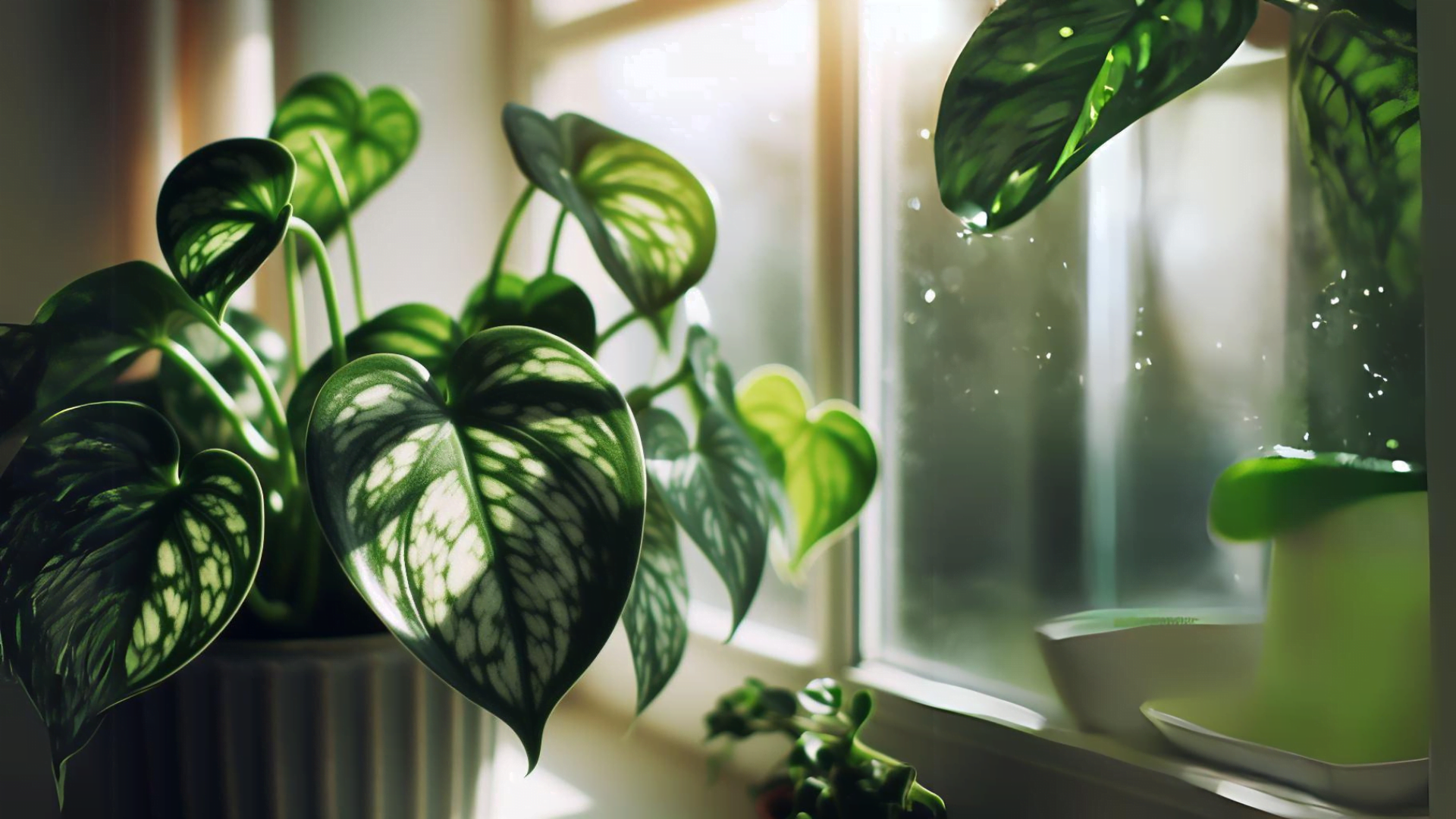
East-facing window, West-facing window For marble queen Pothos
a Marble Queen Pothos expert Boyce and Mayo in the journal “Folia Malaysiana” mention that marble queen grows in usual indoor temperatures which are between 18 to 29°C (65–85 °F). but It can also survive in a bit colder or warmer temperatures for a short period.
if it is too hot for too long, the leaves may droop, and if it is too cold, the leaves may be damaged.
Do not place your Queen Pothos near a door or window to avoid temperature changes, as this could shock the plant.
If you’re wondering about the humidity for your Queen Pothos, relax! Marble Queen does just fine with regular indoor humidity.
if you live in a hot area or put your plant near the kitchen, you should consider getting a humidifier or using a pebble tray filled with water under the pot for extra moisture.
Because they are heavy feeders, I use a lot of fertilizer during the growing season. When the growing season first starts, feed your pothos slow-release pellets. Due to their quick growth, they should be fertilized once every two months in the fall and winter and once a month in the spring and summer.
Even with the perfect lighting, temperature, humidity, and fertilizer levels, if your plant drops leaves, consider adding a small amount of magnesium and manganese as supplements (RHS.org).



Marble queen pathos grows better in a Well-draining potting mix, so if you want to make your soil, you should mix potting soil, perlite, and orchid bark in equal parts. The goal here is to create a light, Aroid mix.
According to Stephanie at Celebrated Nest, Pathos prefers a slightly acidic pH, so aim for 6.1 to 6.5. However, slightly above or below this range will not harm the plants.
When it comes to watering, Marble Pothos prefers not to be overwatered.
It’s best to allow about half of the soil to dry out before watering again, meaning the top 2 to 3 inches of soil should be dry.
In winter, it’s preferable to let it completely dry out between waterings.
By investing in a moisture meter, you will be able to monitor your plant’s soil much more easily and avoid any signs of issues such as yellowing leaves, wilting, or root rot.
Consistency is key, so it’s advisable to establish a watering schedule and stick to it.
Size: Trails 6 to 10 feet, can grow longer
Color: The leaves are white with cream, silver, yellow-green, and blue-green spots.
Manjula Pothos is a hybrid resulting from crossing Marble Queen Pothos and N’Joy. It’s distinguished by its wider, heart-shaped leaves with wavy edges, unlike the flat ones. Additionally, its color tends to be more white than green, resulting in slower growth. Therefore, it’s recommended that it be placed in a bright location to support its growth.
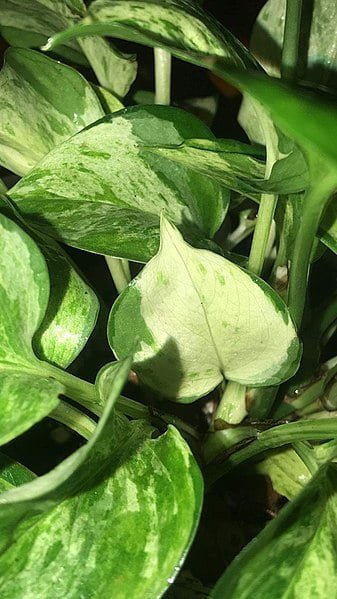
Manjula pothos │ picture By : Juliengagne18
Size: Trails up to 10 feet, up to 2 feet wide
Color: Mottled dark green with yellow and white.
The Marble Queen Pothos we are focusing on today is known for its beautiful variegated appearance, which is more white than green. It performs best when placed in brighter areas, which helps with better growth.

Marble Queen pothos │picture by Maja Dumat
Size: Trails up to 10 feet, up to 2 feet wide
Color: Medium to dark green
Jade Pothos is the easiest houseplant to grow in the Pothos family due to its high tolerance for changing light conditions.
It can perform well in both low light and high light.

Jade pothos │ picture by
Sunlit Farms
Size: Trails up 9 feet long
Color: Green centers surrounded by cream.
With heart-shaped leaves splashed with creamy white, N’Joy Pothos is one of the most elegant Pothos plants. Its low maintenance makes it suitable for beginners.
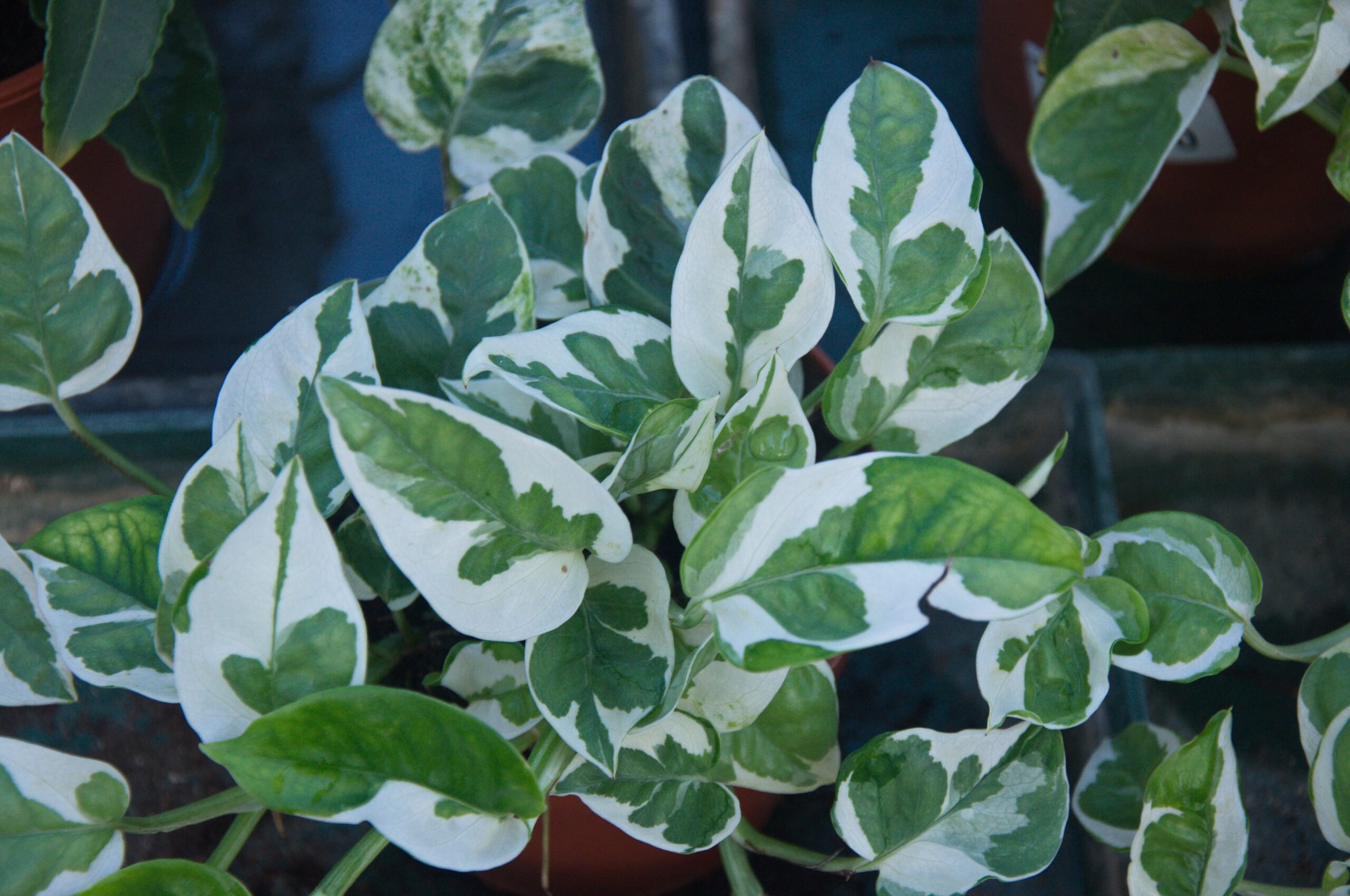
N’Joy pothos │ picture by : Stefano
Size: Trails 5 to 10 feet, and to 2 feet wide
Color: Medium-dark green leaves with different creamy gold spots.
Golden Pothos, scientifically labeled as Epipremnum aureum, is a favored choice among indoor gardening enthusiasts for its stunning appearance and easy upkeep. Its shiny, heart-shaped leaves display a mix of vibrant green and golden-yellow tones, creating an eye-catching look.
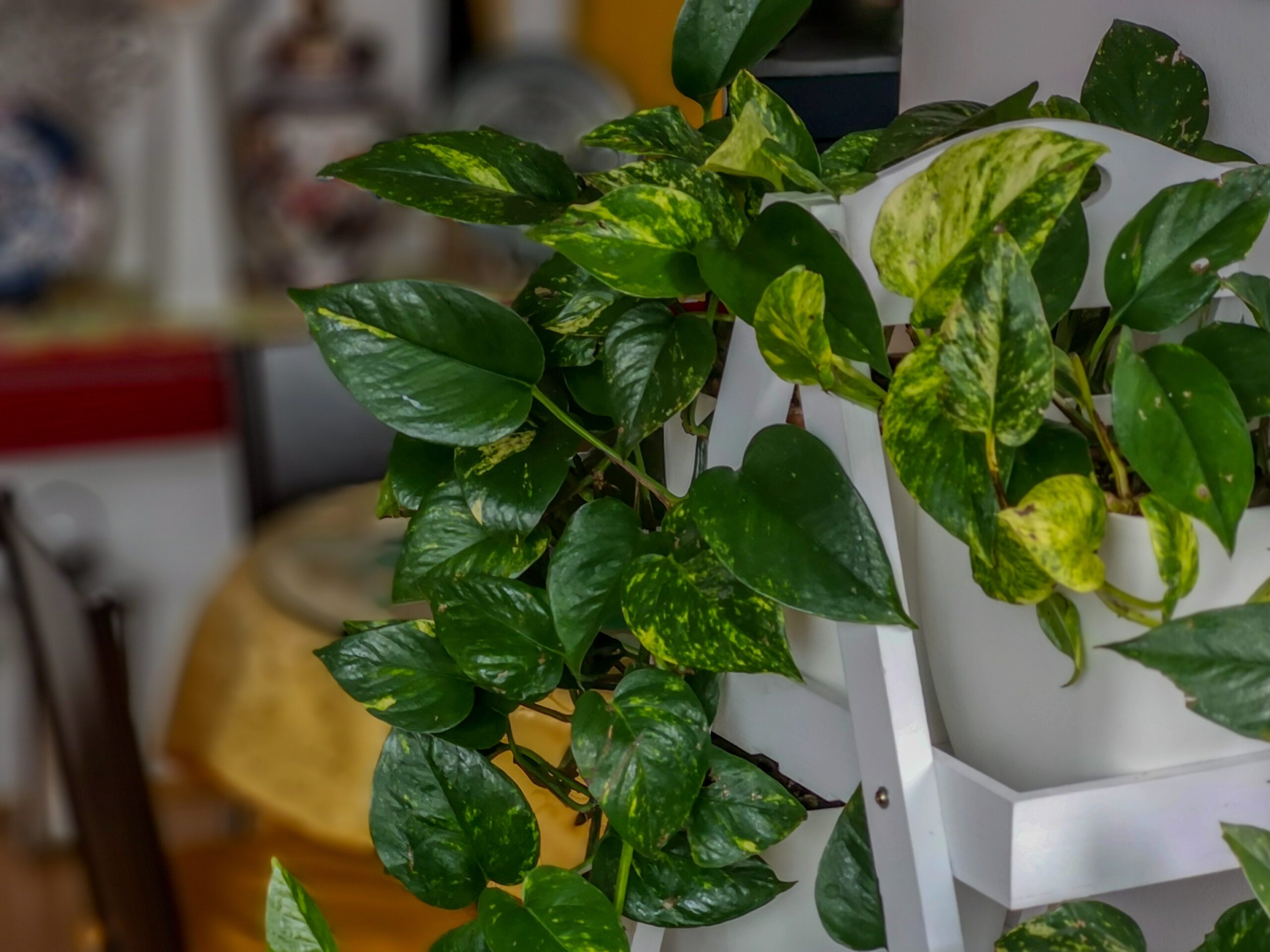
Golden Pothos │ picture by: I.J. Kasim
Size: Trails up to 10 feet, up to 2 feet wide
Color: Blue-green foliage
Like other Pothos plants, Cebu Blue is easy to care for. It earned its name because of its blue-greenish foliage. It prefers medium to bright indirect light and cannot thrive in low light conditions.
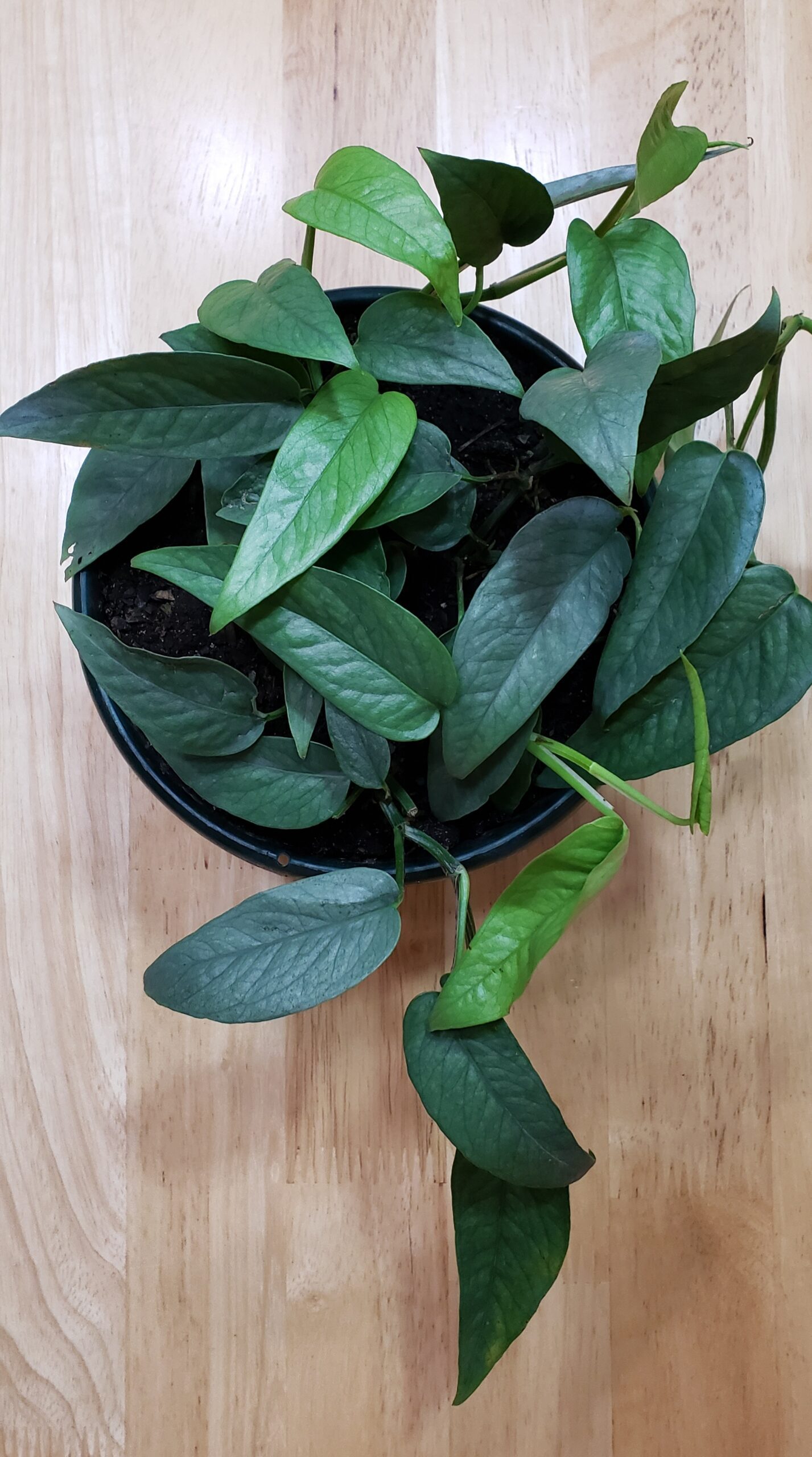
Cebu Blue pothos │picture by MDawny72
Size: Trails 6 to 10 feet, can grow longer
Color: Foliage is chartreuse
It got its name for two reasons: its bright color and its ability to brighten dark spaces. The leaves perform better in medium indirect light, as neon pothos foliage may fade to green in bright light.

Neon Pothos │ picture By : Quinn Dombrowski
It’s easy to propagate Marble Queen Pothos, especially through stem cuttings.
Propagation not only helps the plant become healthier and fuller but also allows you to create more plants, perfect for sharing with friends and family.
It’s best to propagate Marble Queen Pothos during spring and summer when the plant is in its active growing phase. This helps the plant recover from the cutting.
Propagating during the winter or fall is less likely to be successful due to the plant’s slower growth during these seasons.
So, follow these easy steps to propagate Marble Queen Pothos successfully:



You might wonder why you’d want to repot your Marble Queen Pothos. Well, as the plant’s stem grows, so do its roots, leading to a condition known as rootbound, where the roots become overcrowded.
The biggest indicator is a droopy appearance, even if you’re providing optimal conditions, from watering to fertilizing.
Another sign is if your plant has been in the same pot for more than a year or two.
If you notice any of these indicators, wait for spring or early summer, then follow these steps:

Marble Queen Pothos can be affected by many kinds of pests, but the most common ones are:
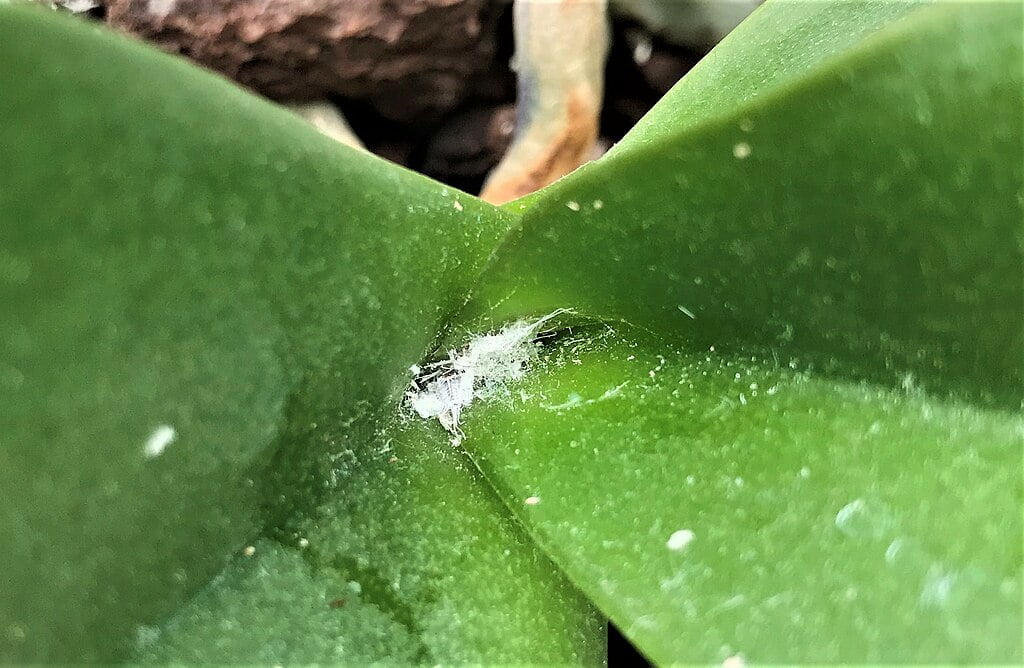
So, you need to schedule regular inspections of the plant for signs of pests.
If your plant is affected, you don’t need to worry because some simple treatments can be applied to get rid of any pests.
My plant suffered from both mealybugs once and scales another year, and I wiped the affected areas with a cotton ball dipped in 70% alcohol.
And I started seeing results almost instantly. The same night I applied the treatment, I found that mealybugs were dropping to the ground.
Along with using alcohol, you can also use insecticidal soap or neem oil. They are both effective and don’t damage your plant in any way.


Root rot is another issue that may affect your Marble Queen Pothos. Overwatering the plant is the main reason for this problem, so make sure to respect the recommended levels of watering as mentioned above.
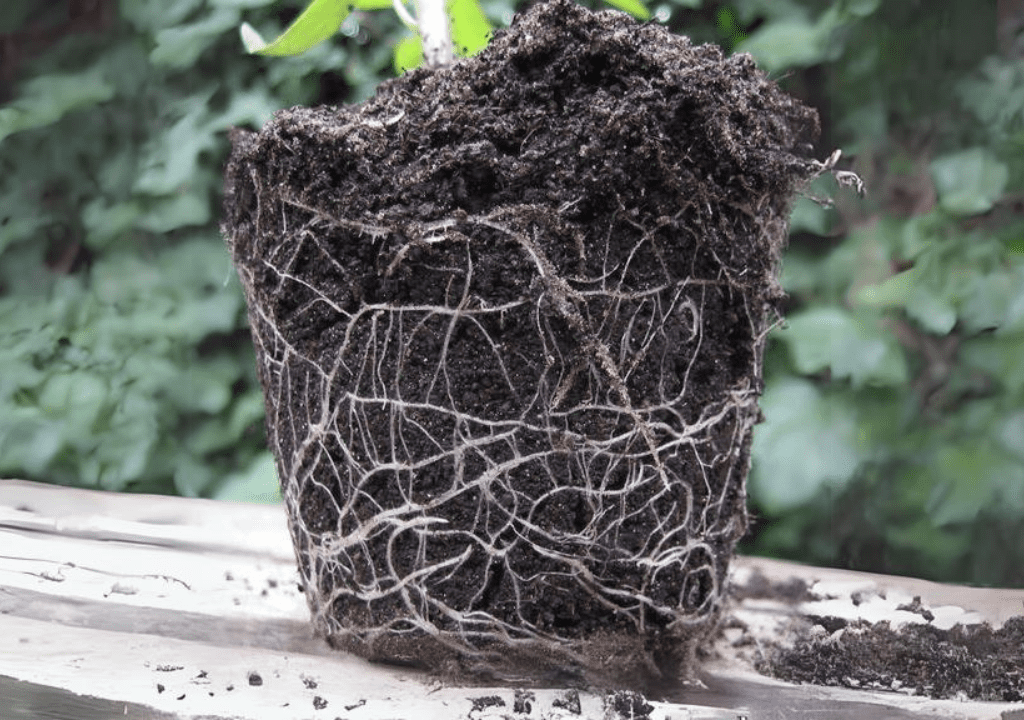
As we said at the start of the article, Marble Queen Pothos is one of the easiest houseplants to care for.
You need to water it properly, place it where it can have the ideal amount of light, in addition to repot it every couple of years.
However, if one of these simple steps isn’t respected, you may encounter some of the issues mentioned below.
The most common problem you may face with Queen Pothos is browning leaves.
While it’s true that Queen Pothos doesn’t like to be watered excessively, it also doesn’t like to be underwatered.
Underwatering is the main cause of browning leaves. If you are sure that you are keeping your watering in check, the second and last reason could be low humidity.
This is often caused by placing the plant in a dry location, such as near the kitchen, windows, or heating vents. It’s better to find a suitable location for it right from day one.
Another common problem you may encounter is seeing your beloved Marble Queen’s leaves turning yellow. Once again, the cause of the problem is likely related to you.
You might ask, “Why am I the problem?” The answer is that you may not be keeping your plant happy and providing it with ideal conditions.
This time, the problem is not underwatering, like with browning leaves. The issue is overwatering. So, once again, make sure you read the watering section carefully.
You might say, “But Akram, I’m watering it properly!” In this case, if not watering is causing the problem, the next reason will be lighting.
Your Marble Queen might be getting too much direct sunlight. Find a better location for it, and it’s better to do so from day one.
When it comes to displaying Queen Pothos in your home, there are countless ideas, but here are the top five:

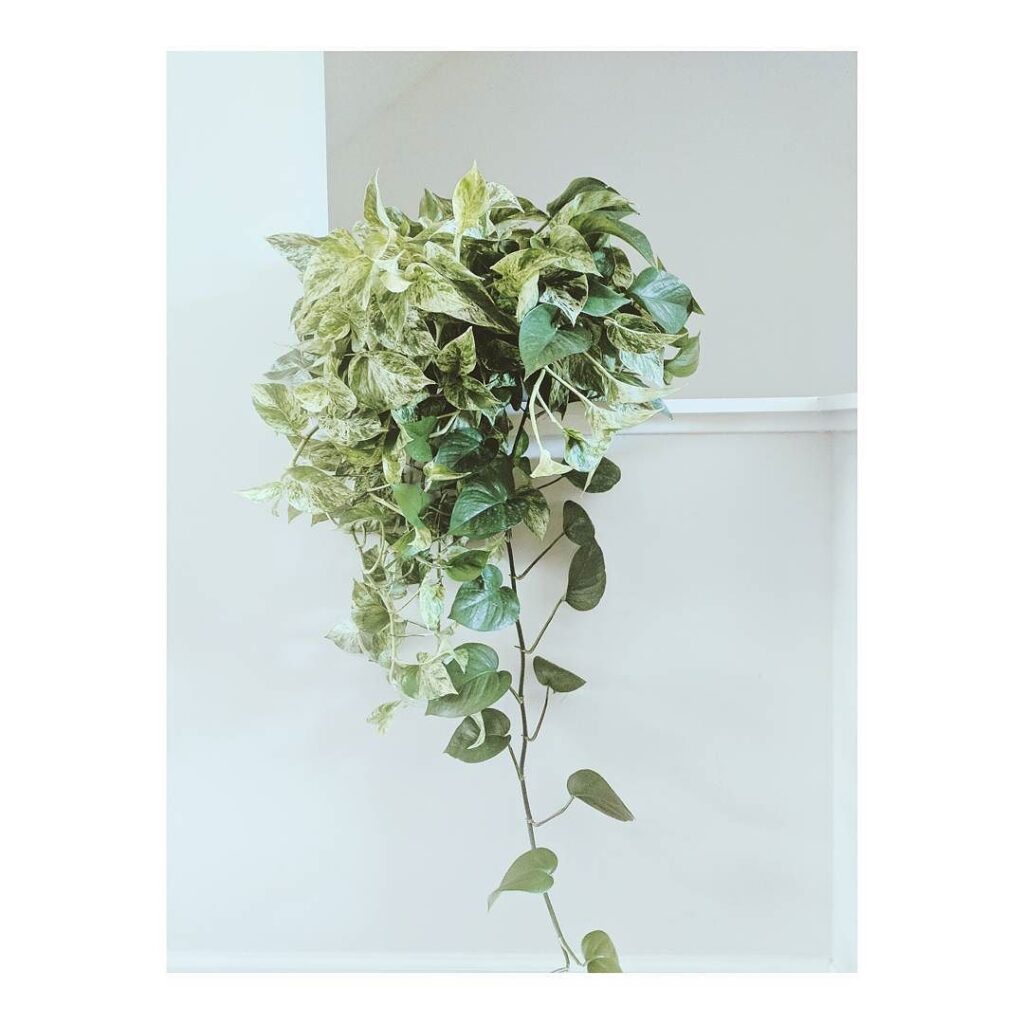
pICTURE bY : yarzka


Maison jar pothos , picture By : Pexles

plants Pots On A Wall , Picture By publicdomainpictures
At Budge to Gadget, we only use reliable, up-to-date sources such as Research papers, books published by respected academic publishing houses, and articles written by well-respected authors. To support the information in our articles. Read our sourcing and fact-check process to learn more about how we fact-check and maintain our material’s accuracy, dependability, and trustworthiness.
Marble Queen Pothos doesn’t mind misting, but it’s not essential. They like it when it’s humid, though.
Repot your Marble Queen pothos when it starts getting cramped in its current pot or if you see roots poking out.
Marble Queen pothos are not super rare, but they’re not as common as regular pothos varieties.
Your Marble Queen pothos might be dying due to overwatering, underwatering, or inadequate light. So, Check its soil moisture and lighting conditions.
Water your Marble Queen pothos when the top inch of soil feels dry. Usually, it’s around once a week or so, but it depends on your home’s conditions.
To keep the white variegation on Marble Queen pothos, provide it with bright, indirect light. also, Avoid exposing it to direct sunlight, as it can scorch the leaves.
Marble Queen pothos can grow up to several feet long, depending on its environment and care.
Pothos, including Marble Queen, grow in bright, indirect light. A north or east-facing window is usually best.
Yes, Marble Queen Pothos is great at purifying indoor air by removing toxins like formaldehyde and benzene.
Yes, Marble Queen pothos can get sunburned if exposed to direct sunlight for too long. furthermore, It’s best to keep it in bright, indirect light to prevent leaf damage.

kahla akram is a professional home decorator, interior designer, and master gardener writer. he is also a seasoned expert horticulturist, with a wealth of experience and a string of impressive achievements. his work has been featured in a multitude of global magazines, and he operates under his highly respected brand, budge to gadget.
Strelitzia Nicolai, also known as the White Bird of Paradise or Wild Banana, is one of the easiest large indoor...
A beginner's guide to successfully grow plumcots fruit at home gardin . from choosing varieties, planting, pollinating to pruning, harvesting...
Your bedroom is more than just a place to sleep—it's your haven from life's stress. It's where you feel most...
Creating a cozy and personalized dorm room can be a fun yet challenging task, especially when you're trying to infuse...
Dorm room walls can be pretty bland, but with the right decor, you can transform them into a reflection of...
Subscribe to our newsletter for the latest decoration designs, ideas, and tips. Stay connected with us!